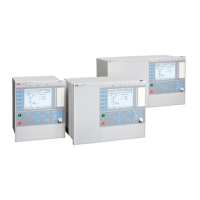Observe that the zones that are not tested have to be blocked and the zone that is
tested has to be released.
4. Repeat steps 1 to 3 above to find the operating value for the phase-to-ground fault
L3-G according to figure
30 and table 25.
Test points 8, 9, 10 and 11 are intended to test the directional lines of
impedance protection. Since directionality is a common function for
all 5 measuring zones, it is only necessary to test points 8, 9, 10 and
11 once, in the forward direction in order to test the accuracy of
directionality (directional angles). Directional functionality testing
(trip inside, no-trip outside) should always be made for all
impedance zones set with directionality (forward or reverse).
11.4.5.2 Measuring the operating time of distance protection zones
Procedure:
1. Subject the IED to healthy normal load conditions for at least two seconds.
2. Apply the fault condition to find the operating time for the phase-to-phase fault
according to test point 10 in figure 29 and table 24 for zone 1. Compare the result of
the measurement with the setting tPP.
3. Repeat steps
1 to 2 to find the operating time for the phase-to-ground fault according
to test point 10 in figure 30 and table 25. Compare the result of the measurement with
the setting tPG.
4. Repeat steps 1 to 2 to find the operating time for all other used measuring zones.
Observe that the zones that are not tested have to be blocked and the zone that is
tested has to be released.
11.4.6 Phase selection, quadrilateral characteristic with settable angle
FRPSPDIS (21)
Prepare the IED for verification of settings as outlined in section
"Preparing for test" in
this chapter.
The phase selectors operate on the same measuring principles as the impedance measuring
zones. So it is necessary to follow the same principles as for distance protection, when
performing the secondary injection tests.
Measure operating characteristics during constant current conditions. Keep the measured
current as close as possible to the rated value of its associated input transformer, or lower.
But ensure that it is higher than 30% of the rated current.
Section 11 1MRK 504 165-UUS -
Testing functionality by secondary injection
128 Transformer protection RET670 2.2 ANSI
Commissioning manual

